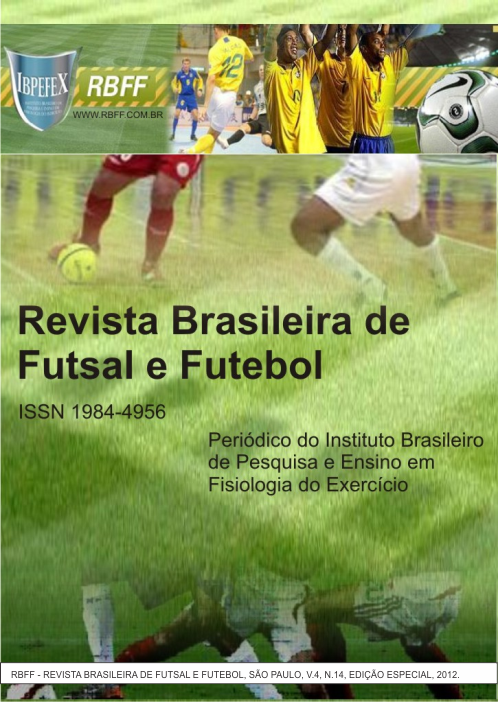Anthropometric Profile of Athletes of Futsal in Stage School City of Limoeiro-PE
Abstract
Since its origin, futsal has become a very popular sport, and therefore has become a phenomenon among school and extracurricular activities. In school perspective, it is necessary to consider besides teaching the principles and fundamentals of the sport, the benefits that brings their practice in physical fitness, since these are teenagers and, at that stage, behavioral and bodily transformations happen, especially in relation to anthropometry and body composition. Meet the anthropometric variables and body composition is necessary since it allows an assessment of the individual and provides a better means for professional intervention. Therefore, this study characterized the anthropometric profile of soccer athletes in school phase of public and private, in the children's category, aged 15-17 years. Participated in the study, 24 futsal players, child category, male, 12 students from a school of public schools and 12 students from the private school, both located in the city of Limon-PE. We measured height, weight and skinfolds. The results of BMI were classified according to the table of the World Health Organisation and the G%, according to the table for children and adolescents 7-17 years. For statistical analysis, we used descriptive statistics to characterize the sample. The analysis was performed by probability distribution (percentage analysis). All were classified as normal BMI and% BF appropriate. There were no significant differences in body composition and G% when comparing the results of the two schools.
References
-Avelar, A. Perfil antropométrico e de desempenho motor de atletas paranaenses de futsal de elite. Revista Brasileira de Cineantropometria e Desempenho Humano. Vol.10. Núm. 1. p.76-80. 2008.
-Dantas, P.M.S.; Fernandes Filho, J. Identificação dos perfis, genético, de aptidão física e somatotípico que caracterizam atletas masculinos, de alto rendimento, participantes do futsal adulto, no Brasil. Fitness Perf J. Vol. 1. Núm. 1. p. 28-36. 2002.
-Faria, V.L.; Araújo, R.N. Prevalência de Sobrepeso e Obesidade em Estudantes na Faixa Etária de 11 a 15 Anos de Duas Escolas da Cidade de Betim -MG, com Perfis Socioeconômicos Diferentes. INCIS. Universidade Vale do Rio Verde. 2008.
-Filardo, R.D.; Añez, C.R.R.; Neto, C.S.P. Antropometria e Composição Corporal de Jovens do Sexo Feminino entre 13 e 17 Anos de Idade. Revista Brasileira de Cineantropometria & Desempenho Humano. 2000.
-Gallahue, D.L.; Ozmun, J.C. Compreendendo o Desenvolvimento Motor: bebês, crianças, adolescentes e adultos. 3ª edição. São Paulo. Phorte. 2005.
-Glaner, M.F. Índice de massa corporal como indicativo da gordura corporal comparado às dobras cutâneas. Revista Brasileira de Medicina do Esporte. Vol. 11. Núm. 4. 2005.
-Gordon, C.C.; Chumlea, W.C.; Roche A.F. Stature, recumbent length, and weight. In: Lohman TG, Roche AF, Martorell R, editors. Anthropometric Standardization Reference Manual. Champaign. Human Kinetics Books. p. 3-8. 1988.
-Guedes, D.P.; Grondim, L.M. Percepção de hábitos saudáveis por adolescentes: associação com indicadores alimentares, prática de atividade física e controle de peso corporal. Revista Brasileira de Ciência do Esporte. Vol. 24. Núm. 1. p. 23-45. 2002.
-Guedes, D.P.; Guedes, J. Manual Prático para Avaliação em Educação Física. Manole. 2006.
-Lohman, T.G. Measuring body fat using skinfolds [videotape]. Champaign, IL: Human Kinetics. 1987.
-Melo, F.A.T. O Futsal como prática esportiva no meio escolar. Disponível em: http://escola.educacaofisicaa.net/2009/04/o-futsal-como-pratica-esportiva-nomeio.htmlAcessado em: 25/07/2012. 12-Nahas M.V. Atividade física, saúde e qualidade de vida: conceitos e sugestões para um estilo de vida ativo. 3ª edição. Midiograf. 2003
-Organização Mundial da Saúde. http://www.who.int/en/. Acesso em 12/07/2012.
-Villar, R.; Denadai, B.S. Efeito da idade na Aptidão Física em meninos praticantes de futebol de 9 a 15 anos. Motriz. Vol. 7. Núm. 2. p. 93-8. 2001.
Authors who publish in this journal agree to the following terms:
- Authors retain the copyright and grant the journal the right of first publication, with work simultaneously licensed under the Creative Commons Attribution License BY-NC which allows the sharing of the work with acknowledgment of the authorship of the work and initial publication in this journal.
- Authors are authorized to enter into additional contracts separately for non-exclusive distribution of the version of the work published in this journal (eg, publishing in institutional repository or book chapter), with acknowledgment of authorship and initial publication in this journal.
- Authors are allowed and encouraged to post and distribute their work online (eg, in institutional repositories or on their personal page) at any point before or during the editorial process, as this can bring about productive change as well as increase impact and impact. citation of published work (See The Effect of Free Access).





